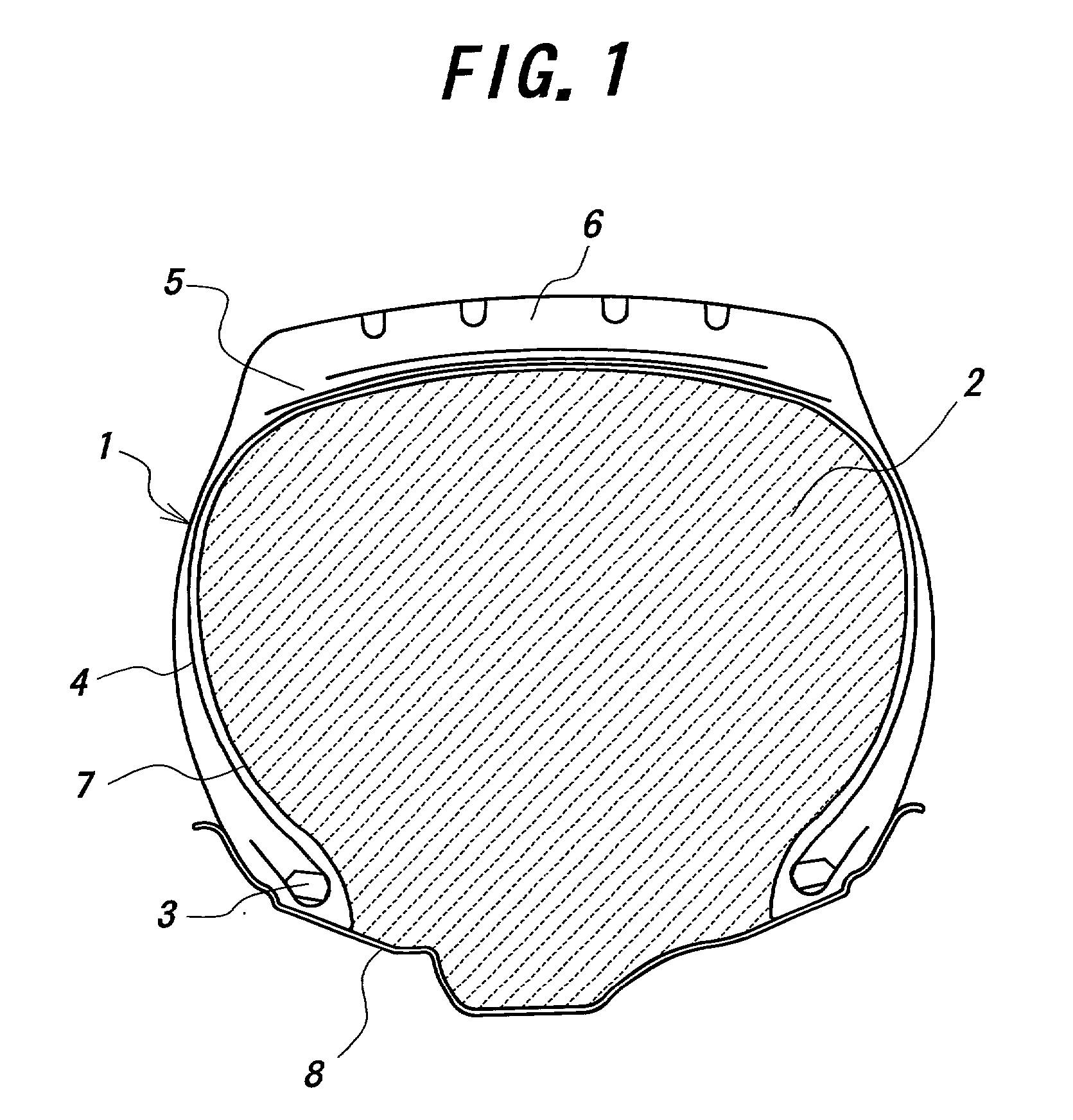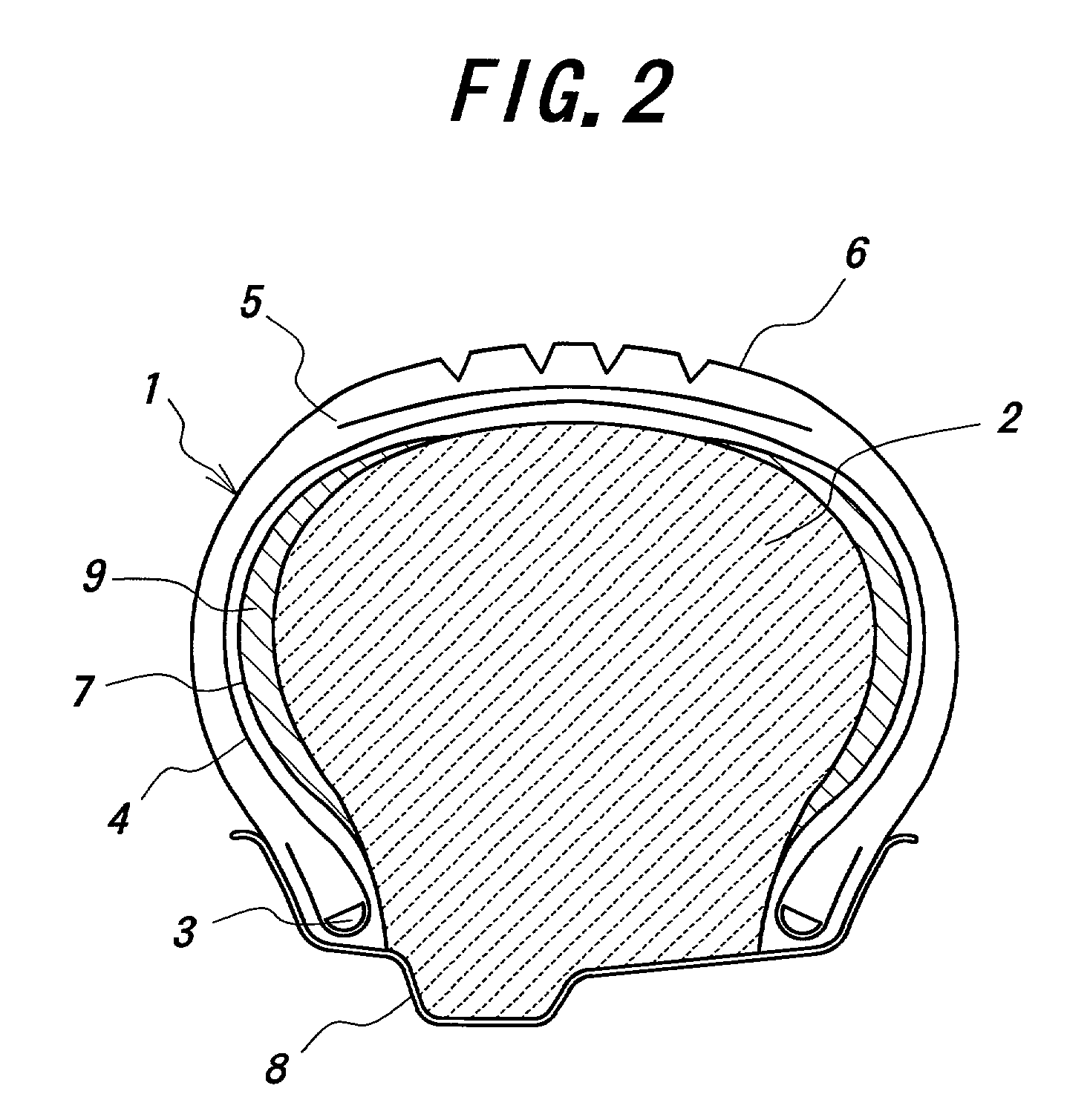When the tire held at the given internal pressure is subjected to an external injury, air leaks out through the external injury toward an exterior to reduce the internal pressure up to an
atmospheric pressure or render into so-called puncture state, so that tension generated in the skeleton portion of the tire is substantially lost.
As a result, the
load bearing function as well as the traction, braking and cornering performances obtained by applying the given internal pressure to the tire are also lost and hence it is impossible to run the vehicle provided with such a tire.
However, the method of adding the sidewall reinforcing layer increases a tire weight by 30-40% and raises a longitudinal spring constant of the tire, so that there is a
disadvantage of bringing about a serious degradation of
rolling resistance and a lowering of ride comfort in the usual running before puncture.
Therefore, this method badly affects the performances in the usual running, fuel consumption and environment, and is a technique being still poor in the general-purpose property.
In this case, however, the tire can not withstand to local repetitive stresses produced between the tire and the internal support body at a run flat state after the puncture, and hence the running distance after the puncture is limited to about 100-200 km.
In addition, there is a problem that an operation of arranging the internal support body inside the tire and assembling the tire onto a rim is complicated and requires a long time.
In this connection, there is proposed means for forming a difference in a rim
diameter between one end side and the other end side in a widthwise direction of the rim to facilitate the
insertion of the internal support body, but a satisfactory effect is not yet obtained.
And also, the composite body is low in the
expansion rate, so that the weight of the composite body having the closed cells is large and it is unavoidable to degrade the ride comfort against vibration and fuel consumption.
In addition to the
disadvantage due to the fact that the internal pressure is very close to an
atmospheric pressure, however, since the foamed body is urethane-base,
energy loss resulted from intermolecular
hydrogen bond of urethane group is large and self-heating is high.
Therefore, when such a foamed body made of urethane is filled in the tire,
heat generation is caused in the foamed body by repetitive deformation during the running of the tire to largely lower the durability.
And also, since something that is hard to form closed cells is used as a starting material, the resulting cells are easily connected to each other and it is difficult to hold a gas in the foamed body, and hence there is a
disadvantage that a desired internal pressure of the tire (
load bearing ability or a deflection controlling ability) is not obtained.
However, in the method of increasing the amount of the
foaming agent compounded, the internal pressure at
room temperature largely exceeds 400 kPa by the increase of the
foaming agent amount and hence it is difficult to use as a replacement of the conventional pneumatic tire.
In the method of raising the
heating temperature, the damage of the tire due to the heat aging becomes large and the durability of the tire is considerably degraded, so that there is caused a problem in the durability for use over a long time.
On the other hand, many expanded pressure cellular bodies each covered with the soft elastic outer
coating are disposed in the inside of the tire-rim
assembly, so that a problem in view of the durability becomes large due to friction of the soft elastic outer coatings producing the above blown to each other, friction of the
coating to the inner face of the tire and the inner face of the rim and the like.
The above problems can be said to be large drawbacks resulted from the arrangement of many expanded pressure cellular bodies different from a case that a shape of the expanded pressure cellular body takes an integrally doughnut shape.
And also, the
small hole formed in the rim is effective to naturally
discharge air of atmospheric pressure inside the tire due to the expansion of the expanded pressure cellular bodies, but serves as a scattering path of the gas in the
cell of the expanded pressure cellular body and hence such a tire can not withstand for use over a long time.
Moreover, the prolonging of the
heating time can not be said to be a good plan because the damage of the tire due to the aforementioned heat aging becomes larger and the lowering of the durability can not be avoided.
While, when the
cell content exceeds 98.75 vol %, the damaging degree of the composite body resulted from the external injury of the tire becomes large and the growing rate of the damage becomes fast, and hence the durability of the composite body to repetitive deformation considerably degrades even in this case.
Similarly, when the internal pressure at 25.degree. C. in the
closed cell is less than 150 kPa, the deflection of the composite body increases and the repeated deformation quantity during the running of the tire becomes large, so that the fatigue history of the composite body in the usual running before the occurrence of external injury in the tire increases and also the growing rate of the damage in the composite body resulted from the external injury of the tire becomes faster with the increase of the deformation quantity.
Even in this case, the durability of the composite body to the repetitive deformation considerably degrades and the performances in the running at a state of creating the external injury of the tire are insufficient.
Because, when the tire is subjected to an external injury, a part of the composite body may be damaged at the inner face of the tire in the vicinity of the external injury and there is a possibility that gas in some closed cells at the damaged zone are scattered off into the exterior of the tire.
Furthermore, a probability of damaging the composite body 2 by the external injury of the tire is very low, and even if the composite body is subjected to the external injury, the zone is extremely restricted, so that the internal pressure given by the composite body 2 never lowers to an extent of spoiling the tire performances.
While, when the average content of the
foaming agent exceeds 50% by weight, it is difficult to obtain the composite body expected in the invention.
Because, the matrix is not durable to the pressure in the cell during the foaming by heating.
If the tire temperature becomes higher than the
softening point of the
polymer constituting the continuous phase, the
cell structure inside the continuous phase is disordered by
fluidization of the continuous phase to bring about the continuing among the cells or serious degradation of the resistance to gas
permeation in the continuous phase and lower the gas holding property of the composite body, so that the internal pressure in the tire lowers and hence the durability of the tire is obstructed.
However, when the
heating temperature of the tire is too high, there is a fear that the degradation of rubber is caused so as not to maintain the basic performances of the tire, so that it is preferable to use a
polymer having a
softening point of not higher than 180.degree. C.
While, when the expansion starting temperature of the foaming composition A exceeds 160.degree. C., there is a fear of heat-aging the tire by heating for the expansion of the foaming composition A.
And also, in order to surely expand only the foaming composition A, the
heating temperature of the tire should be set to a temperature higher by at least 5.degree. C. than the expansion starting temperature of the foaming composition A, otherwise selective expansion is difficult.
Moreover, the above gases such as
butane,
isobutane,
pentane,
isopentane, neopentane and the like are
hydrocarbon and are relatively high in the
solubility to rubber, so that there is caused a fear that the internal pressure of the cell gradually lowers accompanied with the use over a long time and hence the degradation of the tire performances is brought about.
Further, these gases have a flammability under normal temperature and normal pressure, so that it is necessary to keep work-handling conditions in an installation taking the greatest care on flashing and explosion at not only a production course of a product but also a full step from sending and storing of starting materials to forwarding of the product, which may impose a great burden in view of the productivity.
For example, even when the tire performances are improved by applying a rubber having a less heat build-up or a rubber having a high gripping property to it, if the internal pressure of the tire is lowered, there is frequently caused a problem that these performances can not sufficiently be developed.
The tire taken out from the mold after the completion of the
vulcanization step is poor in the shape holding property and is in a unstable state because it is at an elevated temperature state.
As a result, there is feared that the tire becomes hard and the ride comfort and durability are degraded.
And also, a new
heat energy is required for the expansion, which is uneconomical.
Furthermore, it is required to establish a new heating step and an installation for the expansion, which is unfavorable from a viewpoint of productivity.
That is, when the temperature of the tire-rim
assembly at a time of starting the filling of the foaming composition is lower than the expansion starting temperature of the foaming composition, there may be caused problems that a proper expansion is not produced in the inside of the tire-rim
assembly, and a large distribution difference in the
expansion ratio inside the tire-rim assembly is caused to conduct ununiform expansion because the heating should be conducted for sure expansion, and the like, so that it is difficult to obtain the tire expected in the invention.
That is, some time is taken for filling the required amount of the foaming composition and also the difference of
expansion ratio is caused between particles of the foaming composition just after the filling start and particles of the foaming composition immediately before the completion of the filling due to the difference of temperature history, and such a difference of
expansion ratio badly affects the tire performances to no small extent.
For example, the weight becomes ununiform to degrade the uniformity, which induces the occurrence of vibrations in the use of the tire to degrade the ride comfort, steering stability and fuel consumption.
 Login to View More
Login to View More  Login to View More
Login to View More 


